By Bev Caswell, Julie Comay,Christel Durand, Danielle Gutstein, Michael Martins, Ben Peebles, Robin Shaw, Nick Song and Niigaanibines (Don Jones)
This is the story of how a group of educators at JICS gathered to deepen their understanding of treaties in response to the Truth and Reconciliation Commission’s Call to Action 62.1
“… in consultation and collaboration with Survivors, Aboriginal peoples, and educators, to make age-appropriate curriculum on residential school, Treaties, and Aboriginal peoples’ historical and contemporary contributions to Canada a mandatory education requirement for Kindergarten to Grade Twelve students.”
The Junior Years’ Lesson Study Team agreed it was essential to draw on Anishinaabe expertise and perspectives when talking to the Grade 5/6 students about Treaties. Through our work with the Rainy River District School Board (RRDSB) and Seven Generations Education Institute in Treaty #3, we had built strong relationships with Anishinaabe educational leaders. We held Skype sessions with Jason Jones (Native Language Curriculum Coordinator/Land-Based Pedagogy Coordinator, RRDSB), Robert Horton (Anishinaabemowin Coordinator, Seven Gens), and Niigaanibines (Don Jones, former Chief of Nigigoonsiminikaaning First Nation, Treaty #3 Nation). Niigaanibines’ political career has spanned decades and includes expertise in treaty negotiations for the Anishinaabe Nation. Through these enlightening conversations, for which we are deeply grateful, we quickly realized how limited our conception of treaties was. Niigaanibines generously offered to visit the JICS lab school to meet and share ideas, both with the teachers and with the Grade 5 and 6 students. During his classroom visit, he shared stories about his life and experiences with the land. Supplementing these uniquely informative encounters, Jason Jones (Native Language Curriculum Coordinator/Land-Based Pedagogy Coordinator, Rainy River District School Board), and Robert Horton (Anishinaabemowin Coordinator, Seven Generations Education Institute) shared a number of useful resources that helped to deepen our understanding of the topic of treaties.
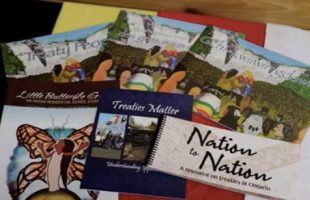
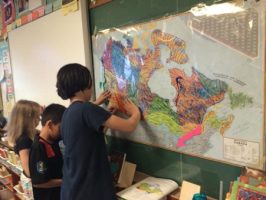
Background to the Lesson
In their previous Grade 4 year, the Grade 5s had carried out an extended study of pre- and post-contact Indigenous history. However, the Grade 4 teacher felt that the topic of treaties needed more exploration and explication. As the teachers built their own knowledge of treaties through reading and conversation with the Anishinaabe experts, their initial probes of student thinking revealed significant misconceptions. They began to design a lesson intended to shift thinking and open up new perspectives, just as the conversations with Don, Jason, and Robert had done for them.
Part 1: Revisiting Previous Learning
The class began by looking at a map they created in Grade 4 that compared the range of ancestral (pre-treaty) lands with the current provincial/territorial boundaries of Canada. There was a buzz of excitement as children recalled their previous year’s learning and pondered questions such as:
What do you remember about this map?
How did the land change after Europeans colonized it?
On the overlay map (showing ancestral lands), is there a “Canada?”Are there provincial or territorial boundaries? What does this mean?
They had clearly been impressed and shocked by how poorly the one representation mapped on to the other. This led beautifully into a subsequent discussion when Niigaanibines (Don Jones) came to visit.
Niigaanibines (Don) Jones: Born on a Trap Line
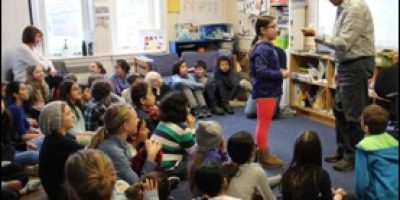
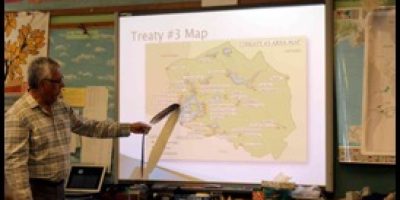
Niigaanibines shared his childhood experiences growing up on a trapline, and told the children:
“If you look on a map, they’re all kind of carved out. But we as First Nations Anishinaabe people we travelled all over, and we didn’t recognize boundaries, we didn’t recognize territories. We called this our ‘gidikimninan’ it is the Anishinaabe term which means “our ancestral lands.” Where we do our livelihood, get our food, get our clothing, get our shelter. Everything, the resources were on the land.”
– Niigaanibines (Don Jones), speaking at the Dr. Eric Jackman Institute of Child Study
Click here for a recorded interview of Nigaanibines speaking about ancestral lands
Revealing student misconceptions: What do you think a treaty is?
We asked the students, “What do you think a treaty is?”
As students discussed their initial understandings of Treaties, a number of misconceptions emerged:
“When colonizers made a deal with Indigenous people. They would each separate and get their own land.”
“The colonizers made a deal with Indigenous people. I don’t know how they got away with it, but they weren’t getting as much land as they were supposed to as when they signed papers, they didn’t know what they were doing, they thought they were getting equal land, but they weren’t getting as much land as they thought they were.”
“It might mean contract or deal between Indigenous people and colonizers. They said we’ll have this land and you’ll have no land, but you’ll still be recognized.”
“A deal. Treaties between Indigenous people and colonizers. But is doesn’t need to be between them. It can be between other people.”
“It’s a deal with a government. A deal for where you live.”
Part Three: A Sacred Promise: Opening up new perspectives
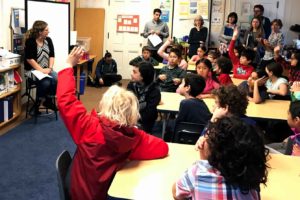
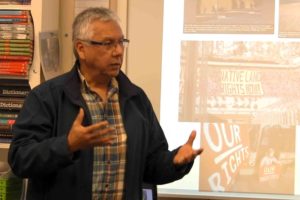
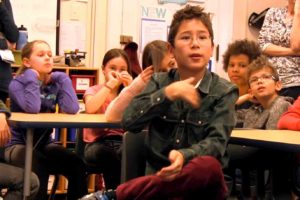
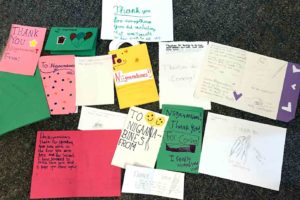
After watching a video-recorded interview with Niigaanibines describing the protocols of Treaty 3, students spontaneously burst into applause. Their comments and questions quickly focused on the unfamiliar idea of a “sacred promise” as it related to the Treaty #3 negotiations in 1873. This notion sparked a shift in their understanding of treaty agreements, which the children were the first to acknowledge.
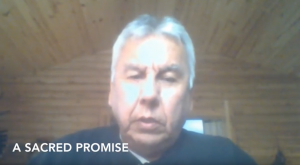
“It’s not really the same, but when kids are like ‘pinky promise’, it’s sacred like it’s a really big promise, and you’ll never go against the promise. It’s as or more powerful than a handwritten agreement.”
“It’s as powerful as it can be. I can’t describe sacred really, but if they are going to shake hands, it’s the most powerful it can get.”
“Trust is a big part of it because there’s no document to show that this happened. You are trusting the other to remember and follow through without a signed document to say what happened. It’s spiritual in a way, promise is really binding.”
“It’s the same as a handwritten thing. It has no more power, but it’s more sacred. It has same values, but when you do it is spiritually binding the two heads of the tribes together.”
“It’s more powerful than a written agreement because it shows trust. We trust each other and promise we’re making to each other that we’re not going to break.”
“When it’s written you have to do this….. If it’s a handshake there has to be trust that it’s going to get done.”
“It’s more than a handshake. It’s a ceremony.”
“A sacred treaty is really important, more important than a handwritten agreement.”
“We thought it was just a paper signing, then we found out it was a sacred promise.”
“I thought it was more like official …It’s more ceremonial, sacred, and significant.”
“A lot of us really don’t know these things. This is new information to us. It will inspire us to learn more about it.”
The Grade 5/6 Lesson Study ended with a series of images intended to encourage the students to make connections to current events.
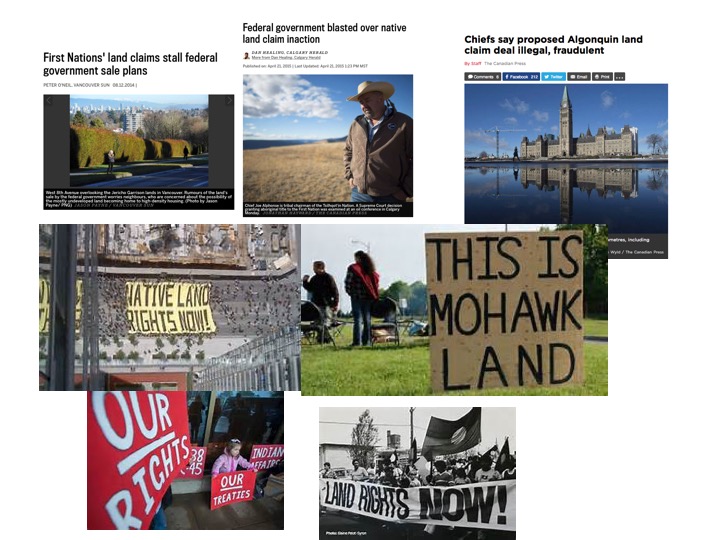
The lab school teachers then reflected on the lesson with Niigaanibines and Jennifer Wemigwans acting as discussants. We can’t stress enough the significance of Niigaanibines’, Jason Jones’, Robert Horton’s, and Jennifer Wemigwans’ contributions to our growing efforts to respond meaningfully to the Truth and Reconciliation Commission’s Calls to Action around education.
We congratulate the Lab School teachers for their humble dedication to new learning and their thoughtful and reciprocal approach to teaching, as well as the Grade 5/6 children who ignored the sizeable adult audience as they invested themselves fully and honestly in deep and emotional learning that will stay with them always.
